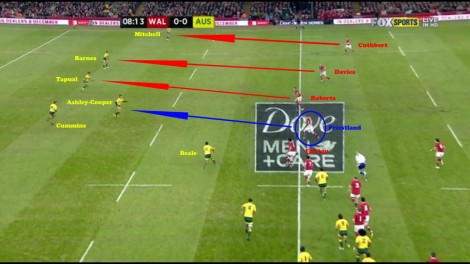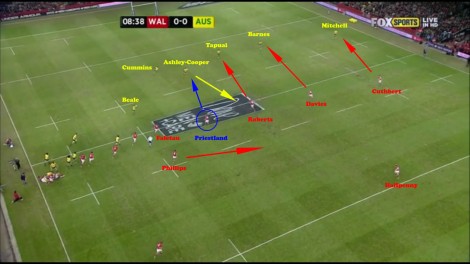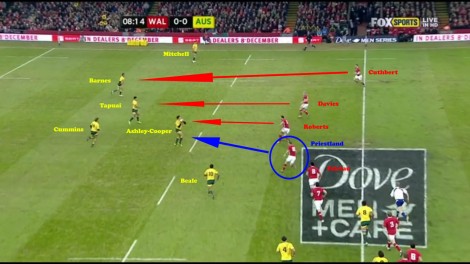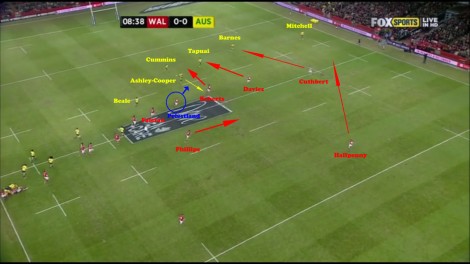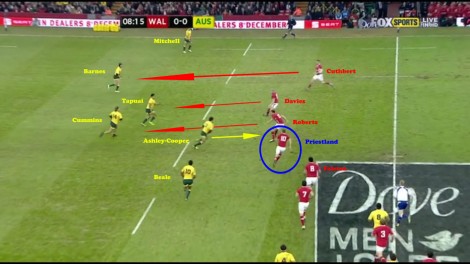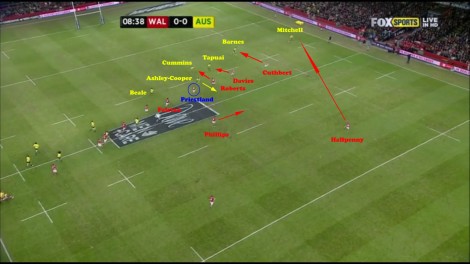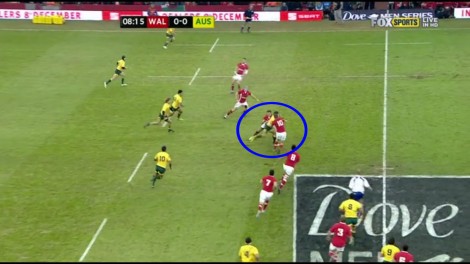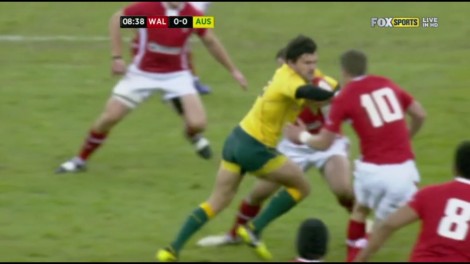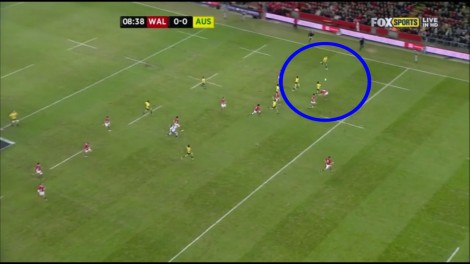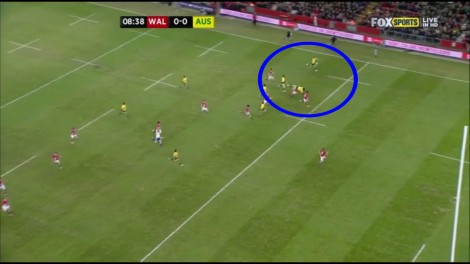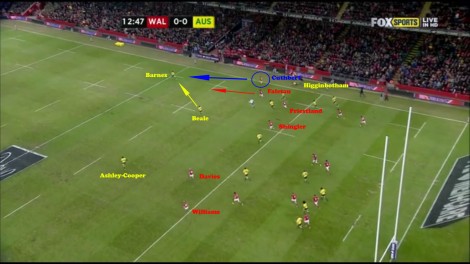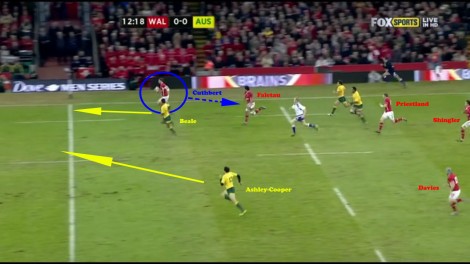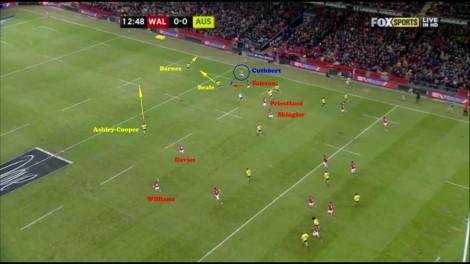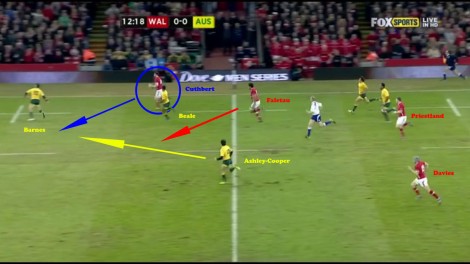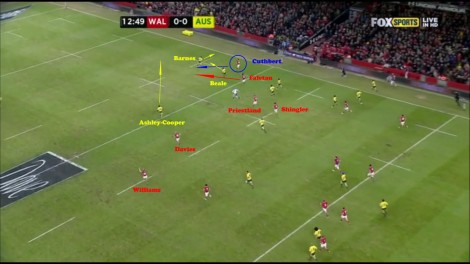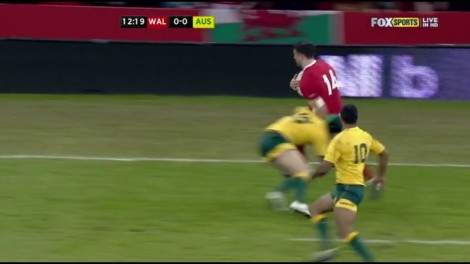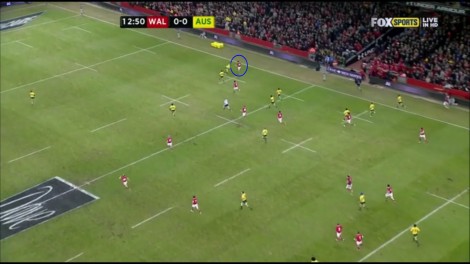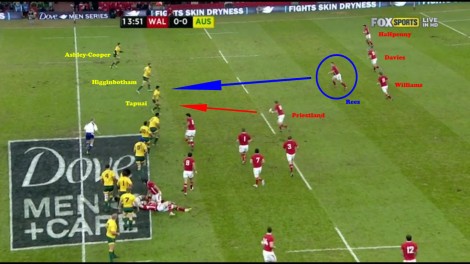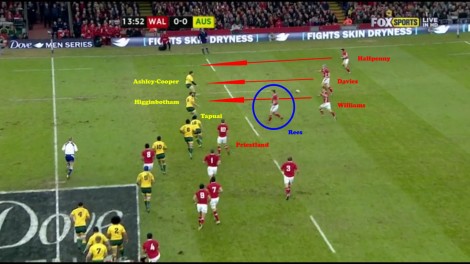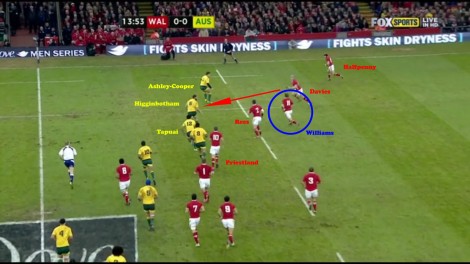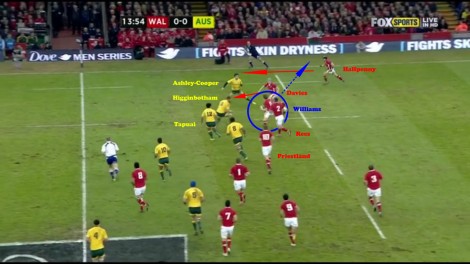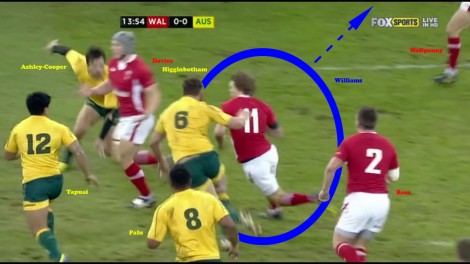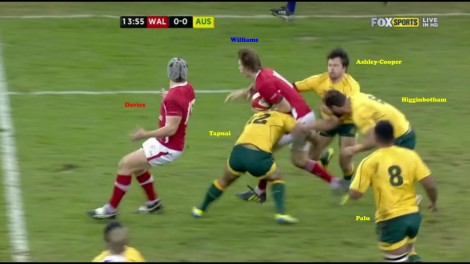While certainly a lack of composure in the final minutes of the match effected the ultimate outcome, Wales made several fundamental errors during the match that will have no doubt had Warren Gatland & Co. seething during the debriefing. Here we visually dissect three examples of crucial mistakes made in the first half.
EXAMPLE 1 – PRIESTLAND’S MISSED TACKLE
Here we can see that initially the Welsh backs are aligned properly. Dean Cummins is the extra man looping around Adam Ashley-Cooper, but regardless of where he comes in, Rhys Priestland must mark Ashley-Cooper. In the second shot you can see Priestland’s shoulder tilted in, indicating that his eyes are on Kurtley Beale, which allows Ashley-Cooper to drift wider unseen.
Cummins begins to enter the line between Ashley-Cooper and Tapuai, so Roberts adjusts his line to take Cummins, and both Davies and Cuthbert shift in to cut off the wide ball. Notice Roberts pointing with his left arm, indicating to Priestland that he is to take the inside. Halfpenny starts to move wide to cover Mitchell who is now open. Priestland is now well inside Ashley-Cooper who receives the ball and heads towards Roberts’ inside shoulder.
Ashley-Cooper attacks the inside shoulder gap off Roberts, who realizes that Priestland might not get there in time and he starts to step back in to attempt to fill the gap. Priestland needs to be going full tilt to make it across.
Priestland appears to arrive just in time, but he goes in far too high and is fended off with ease as Roberts can only get an arm tackle in. Ashley-Cooper makes the break and out-paces Mike Phillips, the cover defender, before throwing a forward pass to Drew Mitchell… or does he?
Upon closer inspection, while the ball does indeed end up in front of where Ashley-Cooper passed it from, it clearly left his hands backwards, which means it was not a forward pass. For those unclear on this rule, you can see a very good IRB explanation of it here. The officials got this one wrong, and Wales dodged a bullet.
Click here to watch the video of the above play.
EXAMPLE 2 – CUTHBERT’S MISSED OPPORTUNITY
In this first image Wales have successfully launched an audacious attack from their own goal line, and Alex Cuthbert has rounded Scott Higginbotham to find himself in space. From here he has two options: attempt to round Berrick Barnes on the outside and score himself, or cut inside and look to pass or offload to Toby Faletau who is close in support. If he chooses the first option, he risks being tackled into touch and losing possession. If he chooses the second, at worst he is tackled and Wales retains the ball with a chance to score. Given that Barnes’ hips are already turned and committed to the outside, either option would require Cuthbert to angle in towards Barnes to either get force him to swivel his hips and open the outside break, or if he stays the same the inside break is on.
As he approaches half way Cuthbert has angled inside somewhat, but Barnes is still committed to the sideline, counting on Kurtley Beale to cover his inside. Faletau remains within passing distance of Cuthbert, and at this point should have been screaming like a banshee to get the ball, as it would have been a 3-on-1 with both Jonathan Davies and Liam Williams wide open to the left and only Adam Ashley-Cooper, who is corner-flagging, in defence. Here you can clearly see Williams with his arm raised calling for the ball to come wide left. If Cuthbert passes here it is almost certainly a try under the posts, but he still has the ball tucked under his left arm, taking away the pass option and making his attack predictable.
It is now too late to pass as Beale is between Cuthbert and Faletau, but the inside break is still very much on. Barnes remains absolutely committed to the outside and all Cuthbert has to do is step off the right foot and challenge Beale, and there’s a good chance he could break the tackle or at least offload to Faletau. By committing to the outside without checking Barnes first it is all or nothing. Run over Barnes, who is small but a good tackler, or be driven into touch. Once again we see Williams waiting out wide with his arm in the air.
Cuthbert chooses the wrong option, and instead of dropping the shoulder or fending he merely drops his arm and tries to run upright through Barnes, who makes a textbook tackle and drives him over the touchline. This was very poor decision making and not the kind of play that will endear him to the Lions selectors.
Click here to watch the video of the above play.
EXAMPLE 3 – BOTCHED OVERLAP
This one might be even worse. After a few good hit ups, Wales has created an overlap on the right, with effectively five attackers versus three defenders. With Higginbotham out of position in the centres, this is as easy as it gets in test rugby. Priestland recognizes that he has to hold Ben Tapuai, and hit Williams who is coming around as an extra attacker. If Matthew Rees simply runs a hard dummy line straight between Higginbotham and Tapuai, Wales will have three men against Ashley-Cooper out wide. Priestland does his job, but Rees does absolutely nothing. He actually slows down and watches the ball go behind him. Despite his gaffe the overlap is still on if Williams can straighten and pass to Davies.
Williams instead assumes his new role as the villain, and cuts across at an angle. Davies sees what is happening and hits a hard line at Ashley-Cooper’s inside shoulder. The effect is perfect, as Higginbotham sets his feet and Ashley-Cooper turns in, leaving Halfpenny wide open on the right flank.
Davies can’t believe it as he goes through the gap untouched but without the ball. Williams instead keeps it himself, and even with the move still salvageable with a simple pass to Halfpenny he instead runs into heavy traffic and his hammered by Tapuai, who has somehow managed to get back into the play. This was majestic incompetence to put it lightly. Any age grade back, never mind a fully blown international, would have been expected to execute that training ground move properly. We can only hope that both Rees and Williams were raked over the coals for this one.
Click here to watch the video of the above play.
These three incidents occurred in just the first fifteen minutes of play, which is an astonishing feat. Normally you would expect to see mental errors creeping in later in the game when players are exhausted, not at the beginning of a vital home test match. These types of mistakes are totally unacceptable from the calibre of players committing them, and if Wales are to have any hope of challenging for the upcoming Six Nations they will have to be stamped out post-haste, a heady challenge indeed.
